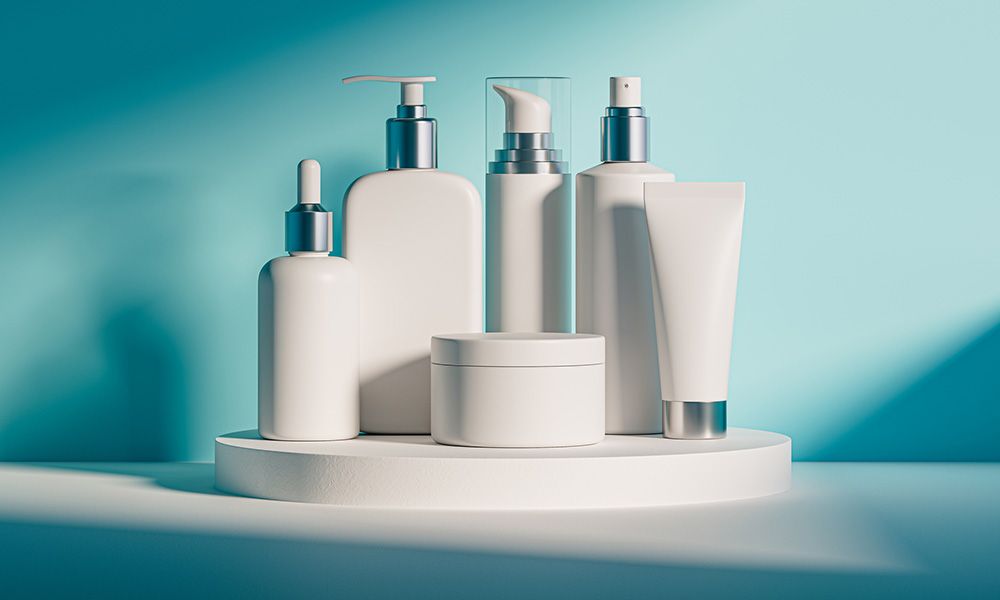Featured
Toxic Skincare Part 2: Beware of These 8 Chemicals

By Charlene Bollinger
February 16, 2024
This article is the second installment of a 2-Part series, so be sure to check out Part 1! In Part 1, I talked about the toxic state of the cosmetics industry in general and also discussed the “Top 5 Toxic Substances” you need to avoid in any skincare product.
Make no mistake, those “Top 5” featured in Part 1 are the “bigwigs” of chemical and synthetic toxins and you definitely want to avoid them! That being said, they really are just the “tip of the iceberg.” Here are eight more synthetic substances that you need to avoid and that you will never find in any CHARLÍS product - ever.
#1 Triclosan
Even though the F.D.A. acknowledges that triclosan may pose a threat to health (and even banned its use in household soap and over the counter antiseptics in 2016), this xenoestrogen is actually used now more than ever. This is because triclosan, an antimicrobial agent, can commonly be found in commercial hand sanitizers. It is also still included in mouth washes, fluoride-based toothpastes, deodorants, lotions, hand creams, and many cosmetics. (1)
The main threat that triclosan poses is to hormonal health. Triclosan used in personal care products has the ability to pass through the skin barrier and into the bloodstream, where it will eventually make its way to the thyroid and other important points along the endocrine system. It is considered a “xenoestrogen” because it can mimic aggressive forms of estrogen. Its use is linked to breast cancer and other reproductive cancers, according to studies at the University of Tennessee, as well as others. (2) Heavy use of products where triclosan is an ingredient can also lead to bacterial resistance.
#2 Polyethylene Glycol (PEGs)
PEGs are a class of chemicals called “ethylene glycol polymers” that are typically used as thickening agents as well as to keep products stable. They are also used to promote moisture retention and to enhance penetration of other substances.
This last characteristic in particular is what poses the greatest threat to human health, where PEGs are concerned. The two main toxins that often accompany PEGs are ethylene oxide and 1,4-dioxane. PEGs penetrating action means that these highly toxic byproducts can, depending on the size of the PEG molecule, penetrate deep into the surface of the skin and even enter into the bloodstream. (3)
Both of these toxic tag-alongs to PEGs are just plain bad news. Ethylene oxide is one of the main ingredients in the creation of mustard gas (a chemical warfare agent first used in world war I). According to the National Cancer Institute, ethylene oxide is highly carcinogenic and is linked to lymphoma and leukemia, as well as stomach and breast cancers. (4) 1,4-dioxane, also commonly found in PEGs, has been classified by the U.S. Environmental Protection Agency (EPA) to be a "probable human carcinogen." It is also linked to respiratory dysfunction and illnesses. (5)
As if these two weren’t bad enough, PEGs may also contain other damaging byproducts such as heavy metals like lead, cobalt, and arsenic. (6)
#3 Butylated Hydroxytoluene & Butylated Hydroxyanisole (BHA & BHT)
BHA, as well as BHT (a close cousin), is a chemical preservative that has been flagged by both US-based and international organizations as harmful to human health. The U.S. The National Toxicology Program (NTP), a department of the National Institutes of Health, currently states that BHA (Butylated hydroxyanisole) is "reasonably anticipated to be a human carcinogen." (7) (8)
Studies have shown that BHA can also do damage to the liver and wreak havoc on the thyroid and the reproductive system. (9) It has been linked with stomach cancer as well as other types of cancer, which is a big reason why BHA is prohibited to be used, even in proprietary fragrance formulas, in the E.U. BHT is closely related to BHA and poses the same basic risks as BHA.
#4 Petroleum
Petroleum-based products like Vaseline and Vicks Vapor Rub have been staples in American medicine cabinets for decades. That’s why it is hard to imagine that there could ever be anything wrong with using them as go-to’s when you need relief.
However, ongoing recent research has found that petroleum use in personal care and cosmetics products may come with some pretty intense risks. The first area of concern lies on the surface of the skin. Many cosmetics and skincare companies use petrolatum and petroleum distillates as a cheap filler so that their products will feel more moisturizing to the touch. However, according to experts, petroleum substances do not absorb well and most of the product may actually remain on the surface of the skin or accumulate inside the tissues. (10) This prevents natural moisture from accessing the skin and also blocks both oxygen absorption and the skin’s ability to detoxify through the pores. All this can aggravate pre-existing conditions like acne.
The second area of concern is even more troubling. Petroleum distillates, just like PEGs, also have byproducts attached to it. One of them is 1,4-dioxane , which I talked about earlier. The other is called “PAH.” PAHs, or Polycyclic aromatic hydrocarbons, are a group of organic compounds that are classified as “probable human carcinogens.” (11)
Petroleum (and its byproducts) can be sneaky; they are often disguised or "hidden" within other ingredients such as paraffin wax, mineral oil, toluene, butanol (and any ingredient with “butyl” in it), EDTA, PEGs, and substances with the prefix “propyl.” It is estimated that the vast majority of all synthetic “fragrance” ingredients are made at least in part from petroleum distillate substances.
#5 Siloxanes
Siloxanes come from silicone and are used in hair products as well as in skin care formulas. Siloxanes make these products easy to apply and quick to dry. They are used in skin moisturizers because they make skin feel smooth and soft.
Siloxanes are very effective in doing these things, but their effectiveness comes with a price. Research has shown that siloxane compounds are extremely toxic, especially for the endocrine system and fertility. A 2015 Korean study found that these chemicals are strong endocrine disruptors. (12) A type of siloxane called cyclopentasiloxane can also be harmful to brain health and the nervous system since it tends to also have an effect on neurotransmitter function. (13)
#6 Diethanolamine (DEA)
DEA is a compound that is used to make skincare products more sudsy and creamier. But they can also be irritating to the skin and much more. DEA is connected to a higher risk of liver cancer as well as thyroid imbalance, according to a study done by the U.S. National Toxicology Program. (14) DEA is a known hormone disruptor and can also deplete the body of choline, which can lead to carcinogenesis, says the writers of a 2002 report in the journal Toxicological Sciences. (15) Choline is a vital natural substance for healthy brain development as well.
#7 Oxybenzone
Oxybenzone is hailed as a protectant against the U.V. rays of the sun and is a common ingredient in commercial sunscreens. It is also a known hormone disruptor. According to a report put together by the Environmental Working Group, oxybenzone has been linked to male infertility and reproductive cancer in both men and women. Other research has linked oxybenzone with skin-related allergies and conditions. (16) Oxybenzone is especially dangerous when coupled with “penetration enhancers,” i.e. chemicals such as PEGs which encourage and accelerate absorption of other substances into the skin.
#8 Isothiazolinones (MI/MIT/MCI/BIT)
Finally, there are isothiazolinones, which sometimes go by the names methylisothiazolinone (M.I./M.I.T.), methylchloroisothiazolinone (M.C.I.), or benzisothiazolinone (B.I.T.). These are preservatives that are used in many skin and hair products to keep them “fresh” on the shelves. However, a report put out by researchers from UCSD, Loma Linda University, and the Dermatitis Academy found that these substances can also cause skin-related irritation and worse. When applied to the skin in moisturizers and other skin products, isothiazolinones raise the risk of allergies and allergic contact dermatitis. Many products that are labels as “hypoallergenic” or “for sensitive skin” may actually still contain isothiazolinones. (17)
Be In The Know and Stay Away from Toxins in Skincare!
Unfortunately, today more than ever, there are thousands of questionable chemicals skincare manufacturers can choose from when creating everything from “fresh” new makeup lines to “luxurious” new moisturizer brands. The bad news is that a lot of these products are anything but fresh and the luxury they sell may come at too high a price for health.
Here at CHARLÍS, we know that what we leave out of our unique, all natural formulations is just as important as what we put in. That is why we not only lab test each bottle to make sure it is 100% ToxicFree(R), we also have strict internal standards regarding substances that will never be added into any of our formulations.
Be in the know about what you put on your skin. Choose only luxury skincare whose ingredients consistently prove to be non-GMO, organic, wild-harvested, and sustainably obtained. That is the CHARLÍS promise– because you are so worth it!
References:
(1) "5 Things to Know About Triclosan." Food and Drug Administration.
(2) Recent Evidence Regarding Triclosan and Cancer Risk
(3) Absorption of Polyethylene Glycol (PEG) Polymers: The Effect of PEG Size on Permeability
(4) Ethylene Oxide EPA Deems Ethylene Oxide A Carcinogen
(5) Toxicological Profile for 1,4-Dioxane
(6) Final report on the safety assessment of PEG-25 propylene glycol stearate, PEG-75 propylene glycol stearate, PEG-120 propylene glycol stearate, PEG-10 propylene glycol, PEG-8 propylene glycol cocoate, and PEG-55 propylene glycol oleate
(7) Butylated Hydroxyanisole.
(8) National Toxicology Program Report on Carcinogens, Fourteenth Edition.
(9) Effects of butylated hydroxyanisole on the development and functions of reproductive system in rats
(10) Petroleum Jelly May Not Be As Harmless As You Think
(11) Polycyclic Aromatic Hydrocarbons (PAHs) Frequently Asked Questions by the Agency for Toxic Substances and Disease Registry (ATSDR)
(12) Induction of the Estrogenic Marker Calbindn-D9k by Octamethylcyclotetrasiloxane
(13) Direct Human Contact with Siloxanes (Silicones) – Safety or Risk Part 1. Characteristics of Siloxanes (Silicones)
(14) NTP Toxicology and Carcinogenesis Studies of Diethanolamine (CAS No. 111-42-2) in F344/N Rats and B6C3F1 Mice (Dermal Studies)
(15) Diethanolamine Induces Hepatic Choline Deficiency in Mice
(16) The trouble with ingredients in sunscreens
(17) Update on Isothiazolinones
subscription
join our exclusive beauty community
Elevate your beauty journey with personalized recommendations and stay connected with a community that shares your passion for self-care. Subscribe now and embark on a beauty adventure with us!
